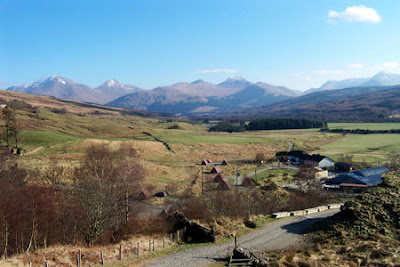1. Tourism in the Cairngorms, Scotland (from SAC - Scottish Agricultural College).
The Cairngorms became Scotland's second National Park in September 2003. The area is also used for a number of tourism activities.
 The Cairngorm funicular is a means of transport, pulled by cables over a track bed, allowing visitor access from the car park area up the mountain plateau. It was designed primarily for winter sports enthusiasts (skiers and snow-boarders) to replace the outdated chairlift system, but is in use all year round. In summer, however, visitors are not allowed to leave the restaurant viewing platform area, due to the potential damage their walking would inflict on the fragile mountain environment and local ecosystem. Much controversy surrounded the granting of the permission for the development to take place, with heated conflicts between conservationists and the developers.
The Cairngorm funicular is a means of transport, pulled by cables over a track bed, allowing visitor access from the car park area up the mountain plateau. It was designed primarily for winter sports enthusiasts (skiers and snow-boarders) to replace the outdated chairlift system, but is in use all year round. In summer, however, visitors are not allowed to leave the restaurant viewing platform area, due to the potential damage their walking would inflict on the fragile mountain environment and local ecosystem. Much controversy surrounded the granting of the permission for the development to take place, with heated conflicts between conservationists and the developers.2. The Cairngorms Campaign
The Cairngorms Campaign is a membership organisation, welcoming individuals and groups as members who support its aims of protection and appreciation of the area. The Cairngorms Campaign strives to prevent unsustainable, damaging developments and argues for better management of the Cairngorms area. It works with landowners, managers, local authorities, government and agencies to this end.
3. Building ban on second homes in the Cairngorms - Times Online
WEALTHY outsiders are to be banned from building new holiday homes in the Cairngorms National Park under plans aimed at stopping rural communities from becoming tourist “ghost towns”.
The park wants to restrict the sale of new housing within its 1,467-square-mile boundaries to people who live, work or have family links in the area. It means that outsiders will no longer be allowed to buy or build new housing for use as second homes or as holiday homes for rent.
The Cairngorms is Britain’s largest national park, with a vast mountain wilderness at its heart. It encompasses large areas of the Highlands, Moray, Aberdeenshire and Angus and is home to 17,000 people and 25 per cent of Britain’s threatened species.
Its spectacular scenery is a magnet for tourists, but in property terms has resulted in an epidemic of wealthy second-homers, who now own one-in-five of all houses within the park. That figure rises to about half in some small villages such as Braemar. The knock-on effect has been a steep rise in property prices, up by as much as 13 per cent a year, placing even the most modest, semi-detached family home beyond the financial reach of locals.
No comments:
Post a Comment